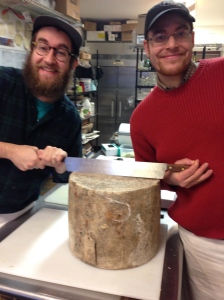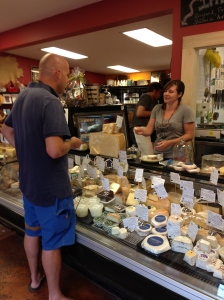“What? You’ve got how many cheeses? I had no idea. I don’t know where to start. I feel so…overwhelmed!”
The clarion cry of the novice cheese lover.
We all know this well. Even cheesemongers with their vast knowledge of cheese were once newbies adrift on the cultured dairy sea, discovering the delights of the open water and navigating the treacherous waves of newness.
We love novice cheese lovers. Let me say that again. We LOVE the novice cheese lover. For the innocent palate, everything is a taste sensation. Everything is bursting, new, uncharted, and unformed without words to cloud the experience. Each experience is a discovery.
The novice cheese lover knows instinctively what he or she likes and dislikes. This is especially true on the physiological level. Researcher Valerie Curtis, Director of the Hygiene Center at the London School of Hygiene and Tropical Health, suggests that our tastes derive from ancient forms of adaptation that draw us toward heath and away from disease. Physiologically, cheese is a really complicated substance for humans because it pulls on competing interests in our brains and bodies. Cheese is made up of microbes, many of which produce for humans a revulsion instinct. Any revulsion toward these cheesy microbes gets contradicted in taste and smell by humans’ hunger drive, which compels us toward sugary foods. Cheese, in its youngest stages, contains lactose, a form of sugar, which turns into lactic acid as it ages. The longer the cheese ages, the less lactose the cheese has; however, as some cheese ages, it develops, regardless of lactose, a sweet, pleasant flavor, sometimes akin to candy. Cheeses of this type especially are Gouda, Comte, and Gruyere whose cultures and cheese making methods bring out the flavor of burnt caramel. Novice cheese lovers experience this dance of competing instincts in one small bite of cheese. Cheesemongers find this delight both incredibly refreshing and fascinating at the same time.
If biology weren’t enough, cheese affects humans on a psychological level as well. As our tastes develop and we try more and different kinds of cheese, humans can intellectually question the disgust instinct to understand the difference between what is really spoiled and what reminds them of spoilage. Psychologist and researcher David Pizzaro reveals that disgust is a hidden emotion that drives most human behavior. What we see, smell, taste and touch can have a dramatic impact on how we feel and perceive others. Disgust can lead to judgment, and as Pizzaro has discovered, oftentimes a stringently conservative attitude. A novice cheese lover might attribute the “disgusting” flavor of a cheese that he or she does not like to the overall experience of being in a cheese shop. That’s okay! It’s merely part of the process of parsing out what you like and those cheeses that are going to give you that lingering feeling of pleasure – after all, cheese contains copious amounts of the chemical opiate phenylethylamine (PEA), which stimulates the production and release of endorphins and serotonin in the brain. Suffice it to say, cheese is an incredibly complex and addictive substance for humans! In time, the novice might discover that her judgment that “all blue cheese is disgusting” is really her association of blue cheese with a bad experience from long ago.
In addition to the physiological and psychological dimensions operating in a bite of cheese, humans also grapple with language to describe their taste experience. Food critic and New York Times reporter Kim Severson says that the first thing a novice has to learn in her food quest is to say “yes” or to say “no.” And that sometimes means saying “no” to the monger who appears pretty darn smart, and with all that knowledge and passion maybe a little unapproachable and possibly arrogant. A cheesemonger’s knowledge of cheese is nothing to be feared: this powerful knowledge of cheese can be harnessed by the novice to steer him in a better direction. Humans instinctively understand food based on a set of “benchmark tastes” collected throughout a lifetime. This means that all humans not only have the capacity to know what they like on a deep level, but also have the ability to incorporate new foods into their palate through a strong repertoire of taste memory. In the following passage from her memoir Spoon Fed: How Eight Cooks Saved My Life, Severson explains the process of what goes on in her mind as she tastes a new cheese. She writes:
Do I like it or not? It’s an all-guts, no-brain call. And if I do, why? This is where the intellectual and emotional work comes in. Why is one cheese better than another? Is it because it is a perfect example of how that particular cheese is supposed to be made? Or does it appeal on some other level? Does the creaminess and funk change how you feel? Does it remind you of mushrooms? Does it bring up memories of the first perfectly grilled cheddar cheese sandwich you ever had? And can you separate the appeal of memory from the actual quality of the food?
A novice cheese lover indeed can navigate the uncharted territory of the cheese shop. Cheese blogger Madame Fromage of DiBruno Brothers in Philadelphia has a fantastic set of guidelines for successfully visiting a cheese shop and getting the most out of the experience called “How to Talk to a Cheesemonger.” 
We at The Cheese Traveler offer this bit of advice to any novice: trust your instincts! Don’t worry about being too polite. A cheesemongers’ feelings won’t be hurt by a simple, “No, that’s not for me.” Ask questions and let your cheesemonger know your tastes. Cheesemongers are here for you. They enjoy helping you in your taste discoveries and in providing you with the best possible experience in the process.
Resources:
Curtis Ph.D, Valerie A. “No Self Control: How motives make us do what we want, not what is good for us.” Psychology Today. Nov. 13, 2013
George, Alison. “The Yuck Factor: The surprising power of disgust.” New Scientist. Issue 2873 (20 July 2012).
Severson, Kim. Spoon Fed: How Eight Cooks Saved My Life. New York: Riverhead Books, 2010.




 t will satiate your sweet tooth and replenish your salt balance. Choose a varietal honey and seasonal jam as well as a fine mustard, cornichons, and olives. Consider adding a handful of nuts and local, seasonal fresh fruit as well.
t will satiate your sweet tooth and replenish your salt balance. Choose a varietal honey and seasonal jam as well as a fine mustard, cornichons, and olives. Consider adding a handful of nuts and local, seasonal fresh fruit as well.